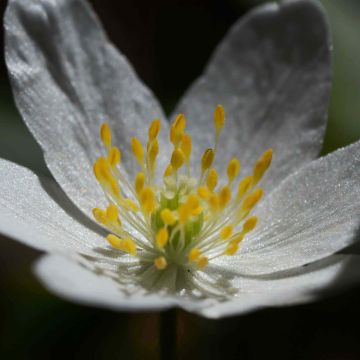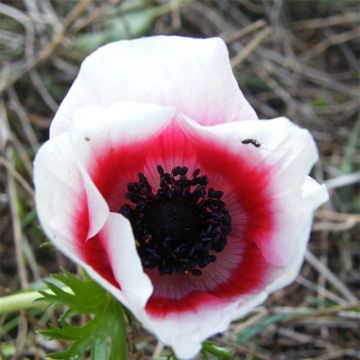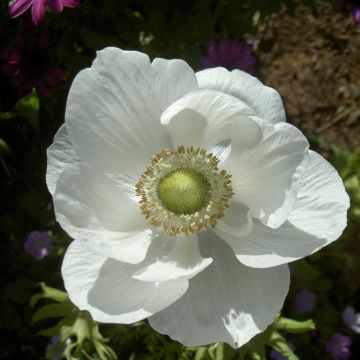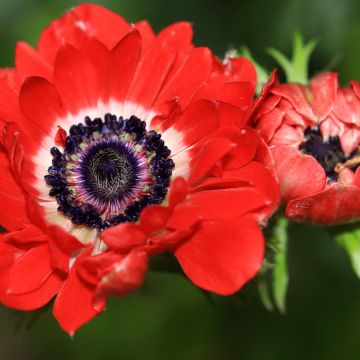

Anemone coronaria St Brigid Mix
Anemone coronaria St Brigid Mix
Anemone coronaria St Brigid Mix
Poppy Windflower, Irish anemone, Garden anemone
Bulbs arrived in good condition, planted immediately to have in the spring.
Christian, 19/10/2021
This item cannot be shipped to the selected country
Delivery charge from €5.90
More information
Schedule delivery date,
and select date in basket
This plant carries a 6 months recovery warranty
More information
We guarantee the quality of our plants for a full growing cycle, and will replace at our expense any plant that fails to recover under normal climatic and planting conditions.
From €5.90 for pickup delivery and €6.90 for home delivery
Express home delivery from €8.90.
Does this plant fit my garden?
Set up your Plantfit profile →
Description
Full of life, cheerful and welcoming, Anemone coronaria St Brigid Mix are a delight to emerge from winter. Their vibrant and varied colours: white, pink, blue, red, lilac are a remedy against gloominess. Their multifaceted flowers bring life to flower beds, borders and rockeries, and brighten up slightly shaded areas. In small bouquets, they also have a great effect indoors.
TAnemone coronaria St Brigid Mix is a hardy bulbous perennial: it can withstand temperatures dropping below -10°C (14°F). However, mulching will help protect it. Native to the Mediterranean basin, it can still be found there in its natural state and therefore prefers light, well-drained soils rich in humus and sunny exposures. It can also tolerate partial shade.
Several stems emerge from its tuberous stump, reaching a height of up to 40-50 cm (16-20in) and bearing beautiful semi-double and double flowers at their top. They have a black centre for the coloured ones (green for the white flowers), surrounded by numerous stamens. The whole flower is highlighted by several rows of rather thin and oblong petals, giving it a half-pompom appearance, more or less flattened and tousled, with a diameter of about 5 cm (2in). The foliage is deciduous and dark green. Arranged in a rosette at the base, deeply cut and sessile on the stems, it forms a beautiful setting for the flowers in bouquets.
Perfect for miniature gardens, Anemone coronaria St Brigid Mix brings life to every corner with bold shades. They extend the flowering season after the Paperwhite Narcissus and the White Star uniflorum Iphéon from April, in the mildest climates. In larger spaces, they take shelter under the graceful grey spirea or the white Korean forsythia and weave their way among the Snake's Head Fritillaries. To enjoy their brilliance, you can also keep them nearby in pots on the patio or near entrances.
Report an error about the product description
Anemone coronaria St Brigid Mix in pictures
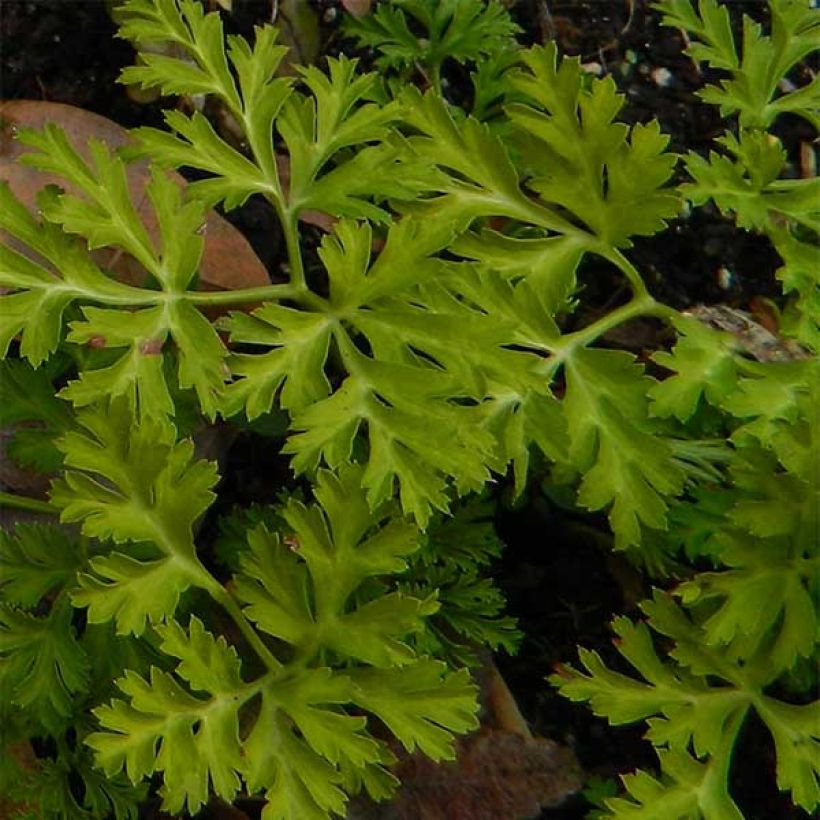

Plant habit
Flowering
Foliage
Botanical data
Anemone
coronaria
St Brigid Mix
Ranunculaceae
Poppy Windflower, Irish anemone, Garden anemone
Cultivar or hybrid
Other Anemone
Planting and care
With a level of cultivation accessible to all, Anemone coronaria St Brigid Mix appreciates all types of soils if they are well drained, with a preference for fertile, sandy and light soils.
The planting of tubers is preferably done in autumn, from mid-September to mid-November, for flowering from April onwards. It is recommended to soak the corms for a few hours just before planting in warm water, in order to rehydrate them. The swellings appearing on the corm after rehydration are the locations of the future flowers. Plant the tubers at a depth of 3 to 5 cm (1 to 2in). Water regularly during the first season, but without excess, to promote good deep rooting.
Very easy to maintain, the Anemone de Caen requires watering in case of drought and a mulch of dead leaves to help it survive the winter (especially if planted in autumn).
At the end of the flowering of Anemone coronaria, cut the withered stems, but leave the leaves that will nourish the tuber for the next year's flowering. They turn yellow and die towards the end of summer, when the plant enters dormancy, only to reappear and bloom the following spring.
Planting period
Intended location
Care
-
, onOrder confirmed
Reply from on Promesse de fleurs
Haven't found what you were looking for?
Hardiness is the lowest winter temperature a plant can endure without suffering serious damage or even dying. However, hardiness is affected by location (a sheltered area, such as a patio), protection (winter cover) and soil type (hardiness is improved by well-drained soil).

Photo Sharing Terms & Conditions
In order to encourage gardeners to interact and share their experiences, Promesse de fleurs offers various media enabling content to be uploaded onto its Site - in particular via the ‘Photo sharing’ module.
The User agrees to refrain from:
- Posting any content that is illegal, prejudicial, insulting, racist, inciteful to hatred, revisionist, contrary to public decency, that infringes on privacy or on the privacy rights of third parties, in particular the publicity rights of persons and goods, intellectual property rights, or the right to privacy.
- Submitting content on behalf of a third party;
- Impersonate the identity of a third party and/or publish any personal information about a third party;
In general, the User undertakes to refrain from any unethical behaviour.
All Content (in particular text, comments, files, images, photos, videos, creative works, etc.), which may be subject to property or intellectual property rights, image or other private rights, shall remain the property of the User, subject to the limited rights granted by the terms of the licence granted by Promesse de fleurs as stated below. Users are at liberty to publish or not to publish such Content on the Site, notably via the ‘Photo Sharing’ facility, and accept that this Content shall be made public and freely accessible, notably on the Internet.
Users further acknowledge, undertake to have ,and guarantee that they hold all necessary rights and permissions to publish such material on the Site, in particular with regard to the legislation in force pertaining to any privacy, property, intellectual property, image, or contractual rights, or rights of any other nature. By publishing such Content on the Site, Users acknowledge accepting full liability as publishers of the Content within the meaning of the law, and grant Promesse de fleurs, free of charge, an inclusive, worldwide licence for the said Content for the entire duration of its publication, including all reproduction, representation, up/downloading, displaying, performing, transmission, and storage rights.
Users also grant permission for their name to be linked to the Content and accept that this link may not always be made available.
By engaging in posting material, Users consent to their Content becoming automatically accessible on the Internet, in particular on other sites and/or blogs and/or web pages of the Promesse de fleurs site, including in particular social pages and the Promesse de fleurs catalogue.
Users may secure the removal of entrusted content free of charge by issuing a simple request via our contact form.
The flowering period indicated on our website applies to countries and regions located in USDA zone 8 (France, the United Kingdom, Ireland, the Netherlands, etc.)
It will vary according to where you live:
- In zones 9 to 10 (Italy, Spain, Greece, etc.), flowering will occur about 2 to 4 weeks earlier.
- In zones 6 to 7 (Germany, Poland, Slovenia, and lower mountainous regions), flowering will be delayed by 2 to 3 weeks.
- In zone 5 (Central Europe, Scandinavia), blooming will be delayed by 3 to 5 weeks.
In temperate climates, pruning of spring-flowering shrubs (forsythia, spireas, etc.) should be done just after flowering.
Pruning of summer-flowering shrubs (Indian Lilac, Perovskia, etc.) can be done in winter or spring.
In cold regions as well as with frost-sensitive plants, avoid pruning too early when severe frosts may still occur.
The planting period indicated on our website applies to countries and regions located in USDA zone 8 (France, United Kingdom, Ireland, Netherlands).
It will vary according to where you live:
- In Mediterranean zones (Marseille, Madrid, Milan, etc.), autumn and winter are the best planting periods.
- In continental zones (Strasbourg, Munich, Vienna, etc.), delay planting by 2 to 3 weeks in spring and bring it forward by 2 to 4 weeks in autumn.
- In mountainous regions (the Alps, Pyrenees, Carpathians, etc.), it is best to plant in late spring (May-June) or late summer (August-September).
The harvesting period indicated on our website applies to countries and regions in USDA zone 8 (France, England, Ireland, the Netherlands).
In colder areas (Scandinavia, Poland, Austria...) fruit and vegetable harvests are likely to be delayed by 3-4 weeks.
In warmer areas (Italy, Spain, Greece, etc.), harvesting will probably take place earlier, depending on weather conditions.
The sowing periods indicated on our website apply to countries and regions within USDA Zone 8 (France, UK, Ireland, Netherlands).
In colder areas (Scandinavia, Poland, Austria...), delay any outdoor sowing by 3-4 weeks, or sow under glass.
In warmer climes (Italy, Spain, Greece, etc.), bring outdoor sowing forward by a few weeks.



































